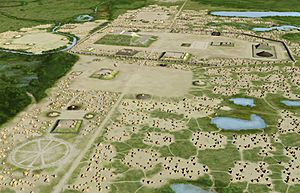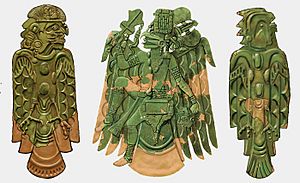Mound 34 facts for kids
| Location | Collinsville, Illinois, Madison County, Illinois, |
|---|---|
| Region | Madison County, Illinois |
| Coordinates | 38°39′39.06″N 90°3′24.41″W / 38.6608500°N 90.0567806°W |
| History | |
| Cultures | Middle Mississippian culture |
| Site notes | |
| Excavation dates | 1950, 1956, 1999-2010, |
| Archaeologists | James B. Griffin, Albert Spaulding, Gregory Perino |
| Architecture | |
| Architectural styles | platform mound, copper workshop |
Mound 34 is a small, flat-topped hill called a platform mound. It's found about 400 meters (1,300 feet) east of Monks Mound at the famous Cahokia Mounds site. This site is near Collinsville, Illinois.
Archaeologists dug near Mound 34 between 2002 and 2010. They found the remains of a special workshop where people worked with copper. This amazing discovery was actually found in the 1950s by an archaeologist named Gregory Perino. But it was then lost for 60 years! So far, this is the only copper workshop ever found at a Mississippian culture archaeological site.
Contents
Building Mound 34: A Look at Its History
The area where Mound 34 stands was once a busy village. This was during the Emergent Mississippian period, starting around 800 CE. People lived here, built houses, and left behind lots of everyday items. They also had a copper workshop.
Later, between 1000 and 1200 CE, the village grew. There was a large building, possibly 10 meters (33 feet) by 6 meters (20 feet). It had a fireplace in the middle.
Around 1200 to 1275 CE, a big construction project began. The old village was cleared away. In its place, the "Ramey Plaza" was built with many mounds around it. This plaza and its twenty mounds are the second largest group at Cahokia. Mound 34 is at the northern end of the mounds that form the western edge of the Ramey Plaza.
To build these mounds, workers had to level the ground. They removed up to 2 feet (0.6 meters) of old village dirt. This dirt, along with soil from nearby borrow pits (places where earth is dug up), was used to build the mounds. Mound 34 was built as a low, rectangular platform mound. It was lined up north to south, like most of the Cahokia site. It also had a flat area, like a porch, on its west, north, and east sides.
A building was constructed on top of Mound 34. Inside this building was a large, round fireplace. Later, between 1275 and 1350 CE, more earth was added to the mound. This made it even taller.
Special Connections and Bird Ceremonies

Archaeologists found many interesting things when they dug at Mound 34. These included different kinds of pottery, beads made from shells, and pieces of copper. They also found nearly 100 special flint arrowheads from Cahokia. One necklace had a shark's tooth with a hole in it.
Several groups of whelk shell cups were found. These cups, along with many engraved shell pieces, were discovered inside the mound. One group of six whelk cups and a local mussel shell is thought to be a special gift. It was likely placed there when the mound construction began.
The designs on the engraved shells and pottery pieces are linked to the Braden style. This style is part of the Southeastern Ceremonial Complex (S.E.C.C.). These are some of the earliest known examples of this important art style.
Animal bones found at the site show that people held feasts there. This happened even before the mound was built. Many bird bones were found, some of which are the only examples of certain bird types at Cahokia. This suggests the site was important for ceremonies involving birds. Many bird wing bones and other body parts were likely used for decoration, not for food.
Bird images, especially falcons, were very important. They were often shown with warriors. This "Birdman" image is a major theme of the S.E.C.C. Similar engraved shell gorgets (necklaces) and cups were found at the "Great Mortuary" at Spiro Mounds in the 1930s.
Scientists used Radiocarbon dating to figure out the age of items from Mound 34. They found that the S.E.C.C. items from Mound 34 are older than those from Spiro. This suggests that the Braden style may have started at Cahokia. Other bird-related ceremonies at Cahokia include stone tablets with birdmen on them. Also, a special burial was found under Mound 72. This burial was of a tall man, about 40 years old. He was laid on a platform covered with over 20,000 shell beads shaped like a falcon.
The Copper Workshop: A Unique Discovery
The area of the copper workshop was first found by Gregory Perino in the late 1950s. Modern digs in the 2000s confirmed its exact location. It was just north of Mound 34. The workshop was a typical Mississippian building with walls made from trenches. It measured about 5.45 meters (17.9 feet) north to south and 4.42 meters (14.5 feet) east to west.
The building had an inside area of about 24 square meters (260 square feet). It was dug about 50 centimeters (1.6 feet) into the ground. The walls had unusual gaps. Archaeologists now think these gaps were vents. They would have allowed air to flow in or let out toxic gases from heating copper.
Inside the building, archaeologists found raw copper nuggets and small pieces of worked copper. They also found stone tools used for shaping copper. Researchers now believe this building was used to turn raw copper into finished products. The remains of three tree stumps were also found. These are thought to have held anvil stones, which are hard stones used as a base for hammering.
Tests on the copper found showed that it had been annealed. This is a technique where metal is repeatedly heated and cooled while it is being shaped. Blacksmiths use a similar method with iron.
The items made at this workshop might have been similar to copper objects found at other Mississippian sites. These include "long-nosed god maskettes" and ceremonial earrings. These earrings had a special shape and were likely used in important rituals. Many copper plates with similar designs, like those from the Wulfing cache in Missouri and some of the Etowah plates from Georgia, are linked to the Braden Style. Many Spiro plates from Oklahoma also fit this style. It is believed that many of these beautiful copper pieces were made at Cahokia in the 13th century.
Archaeological Digs at Mound 34
Mound 34 was marked on early maps of Cahokia. Warren K. Moorehead even tested the site in 1921 and 1922. But the first real excavation was in 1950 by James B. Griffin and Albert Spaulding. Their small digs found many pottery pieces. They also found the first engraved shell cup ever discovered at Cahokia. Pieces of hammered copper plates were also found.
In 1956, Gregory Perino led more excavations, funded by the Gilcrease Museum. He found many shell pieces and a bed of charcoal. He thought the charcoal was from "ceremonial fires." He also found an area covered with copper fragments. Several posts were stained green from copper. He described the area as turning green when exposed to the air. He thought it might be a copper workshop.
In the late 1990s, archaeologists started looking at Perino's old notes and artifacts from Mound 34. They wanted to learn more about the Southeastern Ceremonial Complex and its link to Cahokia. They also hoped to find the copper workshop that Perino had described.
The exact location of the mound had become unclear due to old maps and farming. But the site was found again. From 1998 to 2012, many new excavations took place. In 1999, archaeologists discovered raw copper nuggets and more worked copper pieces. This confirmed that the location was indeed a copper workshop. It was the first confirmed find of its kind at any Mississippian site.




